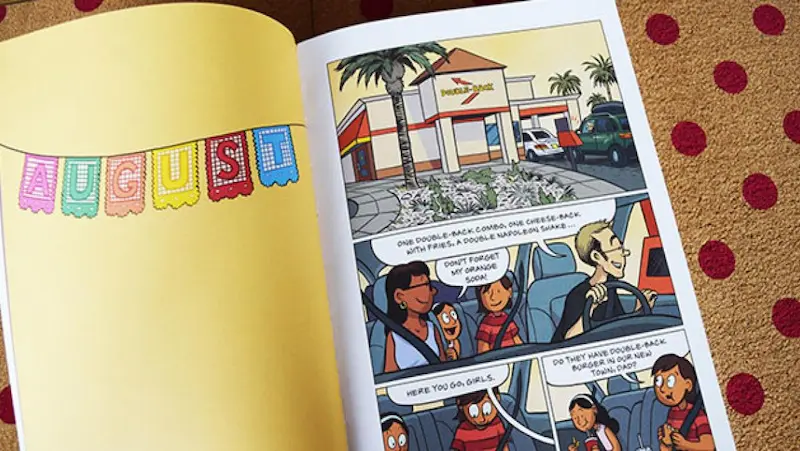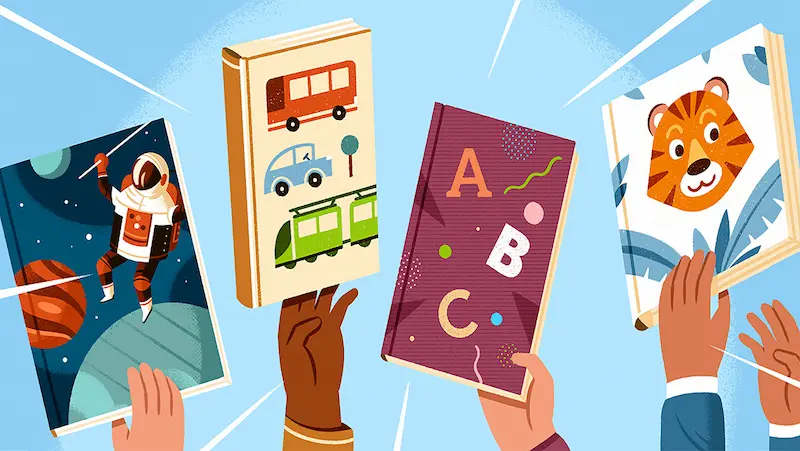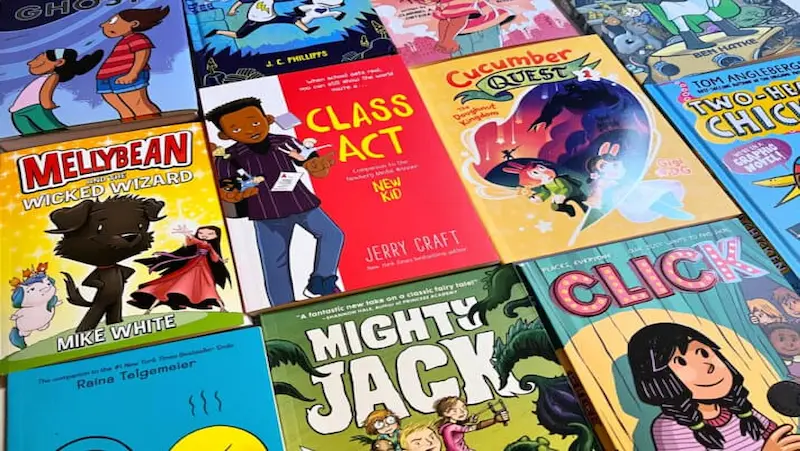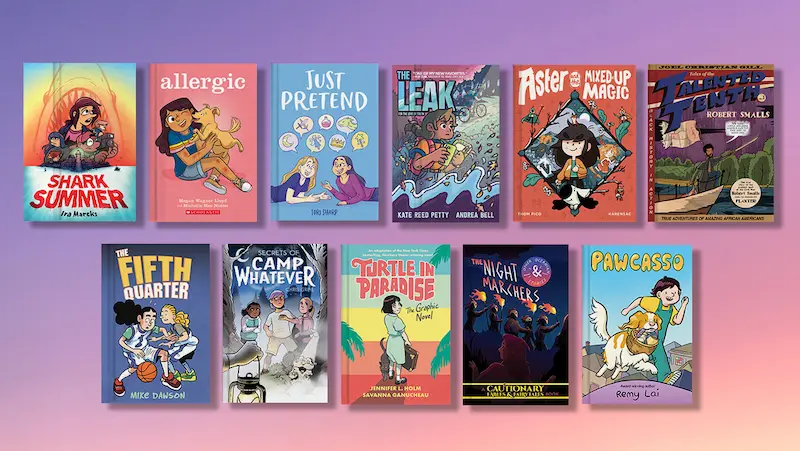In recent years, graphic novels have gained tremendous popularity among children, captivating their imaginations and propelling them into extraordinary worlds.
This unique form of storytelling, blending visual artistry and written narratives, has captured the hearts and minds of young readers worldwide. With their vibrant illustrations, compelling characters, and engaging plots, graphic novels have become a beloved medium for children to immerse themselves in stories like never before.
This introductory piece aims to shed light on the reasons behind the rising popularity of graphic novels among children, uncovering the various elements that make them an irresistible choice for young readers.
First and foremost, graphic novels offer a visual feast for the eyes, combining captivating illustrations with an engaging storyline. The colourful and dynamic artwork not only brings the characters and their adventures to life but also helps children better understand the narrative.
The synergy between the visuals and the written word fosters a deeper comprehension of the story, making it more accessible and enjoyable for children of all reading levels. This visual medium allows even reluctant readers to embark on literary journeys, as the pictures provide valuable context and aid in comprehension.
The medium of graphic novels offers a sense of inclusion and representation. With diverse characters from various backgrounds and identities, children can find relatable heroes and heroines who reflect their own experiences and cultures.
This inclusivity promotes empathy, acceptance, and a broader understanding of the world, fostering a more inclusive and compassionate society.
Table of contents
- Importance of Graphic Novels in Child Development
- Age Appropriateness and Content Guidelines
- Top Recommendations for Graphic Novels for Kids
- Educational Graphic Novels for Children
- Tips for Choosing the Right Graphic Novels for Kids
- Where to Buy Graphic Novels for Kids
- Conclusion
- Frequently Asked Questions
Importance of Graphic Novels in Child Development
In our fast-paced digital era, where visual media and short-form content dominate, reading skills and comprehension often take a backseat. However, the ability to read effectively and comprehend written text is a fundamental skill that not only broadens knowledge but also improves, creativity, communication and critical thinking skills for kids.
Fortunately, with conscious effort and effective strategies, anyone can enhance their reading skills and comprehension abilities. In this blog, we will explore some valuable techniques to unlock the power of words and become better readers.

Building Vocabulary
A robust vocabulary forms the foundation for reading comprehension. The more words we know, the better we can understand written material. Always try provide good books for kids to makes them interested in reading.
To enhance vocabulary, consider the following strategies:
Read Widely: Start from short stories for kids, explore different genres, subjects include inspiring and engaging stories for kids and authors to expose yourself to diverse vocabulary.
Contextual Clues: Use context to decipher the meaning of unfamiliar words. Look for surrounding words, phrases, or sentences that provide hints about the word’s meaning.
Dictionary and Thesaurus: Utilize these tools to learn new words, understand their definitions, and discover synonyms and antonyms.
Active Reading
Reading actively involves engaging with the text, asking questions, and making connections.
Here are some techniques to cultivate active reading habits:
Preview: Before diving into the text, quickly skim through the headings, subheadings, and any visual aids to get an overview of the content.
Questioning: Ask yourself questions about the text before, during, and after reading. This helps to focus your attention and promotes critical thinking.
Annotation: Take notes, underline important points, or highlight key phrases to enhance comprehension and retain information.
Summarization: After reading a section or chapter, summarize the main ideas in your own words. This exercise aids in consolidating your understanding.
Explore some best epic books for kids.
Improving Reading Speed
While reading speed varies from person to person, improving your pace can enhance overall comprehension.
Here are a few techniques to increase reading speed:
Eliminate Subvocalization: Subvocalization is silently pronouncing each word as you read. Minimizing this habit can significantly boost reading speed.
Use a Pointer: Utilize your finger, a pen, or a pointer to guide your eyes along the lines. This technique helps maintain focus and prevents regression.
Practice Chunking: Instead of reading word by word, try to group words together in meaningful chunks. This reduces the time spent on individual words and aids in understanding the overall meaning.
Enhancing Comprehension Skills
Comprehension is the ultimate goal of reading.
To enhance your understanding of the text, consider the following strategies:
Predict and Reflect: Before reading, make predictions about the content based on the title, headings, or introductory paragraphs. After reading, reflect on whether your predictions were accurate and why.
Visualization: Create mental images while reading to help you grasp and remember the information more effectively.
Identify the Main Idea: Practice identifying the main idea or central theme of a passage. This will help you focus on key information and maintain a coherent understanding.
Make Connections: Relate the text to your own experiences, knowledge, or other texts you have read. This helps create a network of connections and facilitates deeper comprehension.
Age Appropriateness and Content Guidelines
Reading is a timeless activity that transcends generations, connecting people through the power of words and stories. However, each age group has its distinct characteristics, interests, and preferences when it comes to reading.
In this blog, we will explore the reading preferences of different age groups, highlighting the diverse ways in which literature captivates and engages readers across generations.

Children (Ages 0-12)
Children possess an incredible capacity for imagination and wonder. For the youngest age group, picture books and board books are essential. These books often feature vibrant illustrations, simple narratives, and interactive elements to engage their developing senses.
As children grow older, they become fascinated by stories filled with magical adventures, talking animals, and relatable characters. Popular genres include fantasy, fairy tales, adventure, and books that address social and emotional themes. Everyone loves fun, the young mind is not different, try to makes them read the funny parts which also help to gain knowledge something like fun facts for kids.
Teenagers (Ages 13-19)
Teenagers are a dynamic and diverse group with rapidly evolving interests. Young adult (YA) fiction is a thriving genre among this age group, offering a wide range of topics that resonate with their experiences. YA books often explore themes of self-discovery, identity, relationships, and social issues.
Genres like dystopian fiction, romance, coming-of-age stories, and fantasy with relatable protagonists are particularly popular among teenagers. They also enjoy books that tackle contemporary issues such as mental health, diversity, and LGBTQ+ representation.
Young Adults (Ages 20-35)
Young adulthood is a period marked by self-discovery, personal growth, and navigating the complexities of adulthood. Fiction and non-fiction genres tend to appeal to this age group. Many young adults enjoy literary fiction, contemporary fiction, and genres like mystery, thriller, and science fiction.
They gravitate towards books that explore themes of identity, ambition, career, love, and personal relationships. Additionally, self-help books, memoirs, and books related to personal development and productivity are gaining popularity.
Middle-aged Adults (Ages 36-55)
Middle-aged adults often seek a balance between entertainment and intellectual stimulation in their reading choices. Historical fiction, literary fiction, and classic novels resonate with this age group.
Many readers in this demographic appreciate thought-provoking stories, rich character development, and intricate narratives. Non-fiction books covering topics such as history, philosophy, biographies, and self-improvement continue to be popular choices as well.
Seniors (Ages 56+)
As individuals reach their golden years, they often have a wealth of life experiences and a desire for reflection. Seniors tend to lean towards books that offer a sense of nostalgia and explore themes of aging, family, and legacy.
Memoirs, historical fiction, and non-fiction books that delve into topics like travel, philosophy, spirituality, and health and wellness are favored by this age group. Many seniors also enjoy participating in book clubs, which provide social interaction and opportunities for stimulating discussions.
Top Recommendations for Graphic Novels for Kids
In today’s fast-paced world, it can be overwhelming for parents, educators, and caregivers to navigate the vast array of recommendations for children’s entertainment, education, and development.
To streamline the process and ensure age-appropriate experiences, categorizing recommendations based on age groups is essential.
In this blog, we will explore the benefits of categorization and provide brief descriptions and key features for recommendations in three age groups: 4-6, 7-9, and 10-12.

Age Group: 4-6 Years
At this stage, children are curious, imaginative, and eager to explore the world around them. Recommendations for this age group should focus on fostering creativity, enhancing cognitive skills, and promoting physical development.
Here are some key recommendations:
Interactive Storybooks: Engaging storybooks with interactive elements and colorful illustrations can captivate young minds and improve their reading skills. These books often include touch-and-feel elements, pop-ups, and sound effects to create an immersive experience.
Building Blocks: Construction toys like building blocks or LEGO sets encourage spatial reasoning, problem-solving, and fine motor skills. They enable children to unleash their creativity by constructing various structures and developing basic engineering concepts.
Art and Craft Kits: Artistic activities such as coloring, painting, and crafting help children express their creativity and fine-tune their motor skills. Kits with safe and age-appropriate materials, along with simple instructions, can inspire imaginative play and boost confidence.
Age Group: 7-9 Years
Children in this age group are more independent, curious, and eager to learn. Recommendations should encourage critical thinking, social skills development, and provide a platform for exploration.
Here are a few recommendations:
Puzzle Games: Solving puzzles and brainteasers stimulates logical thinking, problem-solving, and spatial reasoning. It challenges children’s minds and enhances their cognitive abilities. Age-appropriate puzzle games can range from jigsaw puzzles to logic-based board games.
Science Kits: Science kits with age-appropriate experiments enable children to explore the wonders of the natural world. Conducting hands-on experiments teaches scientific principles, encourages curiosity, and promotes a deeper understanding of the world around them.
Board Games: Board games promote social interaction, strategic thinking, and teamwork. They can be a great way to engage with family and friends while developing essential skills such as decision-making, patience, and sportsmanship.
Age Group: 10-12 Years
Children in this age group are entering their preteen years and are developing their interests and individuality. Recommendations should focus on encouraging independent thinking, building confidence, and expanding knowledge.
Here are some recommendations:
Coding Games: Interactive coding games for kids and apps introduce children to the world of programming in a fun and engaging way. They foster logical reasoning, problem-solving skills, and creativity, laying the foundation for future technological literacy.
Adventure Books: Engaging adventure and fantasy books expand vocabulary, improve reading comprehension, and foster a love for reading. These books often feature relatable characters and exciting plotlines that captivate young readers and nurture their imagination.
Musical Instruments: Learning to play a musical instrument enhances cognitive abilities, boosts creativity, and cultivates discipline. Whether it’s a guitar, keyboard, or drums, playing an instrument can be a rewarding and enriching experience for preteens.
Educational Graphic Novels for Children
In recent years, graphic novels have gained immense popularity among readers of all ages. No longer confined to the realm of superheroes and fantasy, graphic novels have evolved to tackle a wide range of topics, including history, science, and biographies.
These visually stunning and narratively captivating books offer a unique platform for engaging children in learning. By combining compelling storytelling with educational content, graphic novels have become powerful tools that foster curiosity, critical thinking, and a love for reading.
In this blog, we will explore the educational value of graphic novels, focusing on their ability to immerse children in historical, scientific, and biographical themes.

Historical Graphic Novels
History can often be perceived as dry and disconnected from the present. However, historical graphic novels bridge that gap by presenting events and characters in a visually dynamic and accessible format. Books like “Maus” by Art Spiegelman and “Persepolis” by Marjane Satrapi offer engaging narratives set against the backdrop of significant historical events.
Through the use of powerful imagery and captivating storytelling, these books bring history to life, making it easier for children to comprehend and empathize with the experiences of people from different time periods. Historical graphic novels encourage critical thinking, empathy, and a deeper understanding of the complexities of the past.
Scientific Graphic Novels
Science can be a daunting subject for many children, but graphic novels can transform complex scientific concepts into exciting adventures. Books like “The Manga Guide to Physics” by Hideo Nitta and “Science Comics” series by various authors provide visually engaging explanations of scientific principles and discoveries.
By incorporating relatable characters and captivating illustrations, these graphic novels make science more accessible and encourage children to explore the wonders of the natural world. They stimulate curiosity, ignite a passion for inquiry, and inspire future scientists.
Biographical Graphic Novels
Biographies can be incredibly inspiring, but they are often presented in traditional text-heavy formats. Graphic novels offer a fresh perspective, enabling children to experience the lives of notable figures through vivid illustrations and dialogue. Works like “March” by John Lewis, Andrew Aydin, and Nate Powell, and “Anne Frank’s Diary: The Graphic Adaptation” by Anne Frank and Ari Folman, allow young readers to connect with historical figures on a personal level.
These graphic novels humanize important individuals, emphasizing their struggles, achievements, and contributions. By experiencing the stories visually, children develop a deeper appreciation for diverse perspectives and gain insight into the power of resilience and determination.
Engaging Children in Learning
Graphic novels provide a gateway to reading for children who may be reluctant readers or those who struggle with text-heavy formats. The combination of visually appealing artwork and concise text in graphic novels captures attention and keeps readers engaged. The use of panels, speech bubbles, and sequential storytelling helps children develop important reading skills such as decoding, inference, and understanding story structure.
Additionally, the incorporation of historical facts, scientific principles, and biographical details in the narratives promotes active learning and critical thinking. Graphic novels create an immersive reading experience that encourages children to explore further, fostering a love for reading and lifelong learning.
Tips for Choosing the Right Graphic Novels for Kids
Graphic novels have gained immense popularity among children in recent years. They offer a unique reading experience that combines captivating illustrations with engaging storytelling.
With a wide range of options available, it’s essential for parents, teachers, and guardians to carefully select graphic novels that are suitable for children. In this blog post, we will explore some key factors to consider when choosing graphic novels for young readers.

Age Appropriateness
One of the primary considerations when selecting graphic novels for children is age appropriateness. Different graphic novels are designed for specific age groups, taking into account both the complexity of the storylines and the suitability of the content.
Ensure that the themes, vocabulary, and graphic imagery align with your child’s developmental stage and reading abilities. It’s important to choose graphic novels that challenge and engage them without overwhelming or exposing them to mature content.
Content and Themes
Graphic novels cover a wide range of genres and themes, including adventure, fantasy, science fiction, mystery, history, and more. Consider your child’s interests and preferences when selecting a graphic novel. Additionally, take into account the values and messages portrayed in the story.
Look for graphic novels that promote positive themes such as friendship, courage, empathy, diversity, and environmental awareness. A well-chosen graphic novel can provide a platform for meaningful discussions and help children develop important values.
Artwork and Visual Appeal
The visual aspect of graphic novels plays a crucial role in capturing a child’s interest and imagination. Assess the artwork and illustrations to determine if they are visually appealing, well-executed, and complement the storytelling.
Vibrant colors, expressive characters, and attention to detail can enhance the reading experience. Encourage children to appreciate different art styles and explore the diverse range of visual storytelling techniques found in graphic novels.
Reading Level and Text Complexity
Graphic novels offer a unique combination of visual and textual elements, making them suitable for readers at various levels. Consider the reading level and text complexity of the graphic novel to ensure it aligns with your child’s reading abilities.
Some graphic novels incorporate simpler vocabulary and sentence structures, making them accessible for early readers, while others may have more advanced language and complex narratives for older children. Matching the reading level to your child’s proficiency will help foster confidence and enjoyment in reading.
Reviews and Recommendations
Reading reviews and seeking recommendations from trusted sources can provide valuable insights when choosing graphic novels for children. Consider consulting librarians, teachers, and fellow parents who have experience in selecting age-appropriate and engaging graphic novels.
Online resources and websites dedicated to children’s literature can also offer curated lists and reviews to assist in making informed decisions.
Series and Authors
Some graphic novels come as part of a series, providing an opportunity for children to follow beloved characters and storylines across multiple books. Consider introducing your child to graphic novel authors who have a proven track record of producing quality content for young readers.
Exploring an author’s body of work can be an exciting journey for children, as they become familiar with their writing style and artistic vision.
Where to Buy Graphic Novels for Kids
In recent years, graphic novels have gained immense popularity among children of all ages. These visually captivating storytelling mediums have become a gateway to the world of literature, fostering a love for reading and imagination.
Whether your child is a comic book enthusiast or just starting to explore this genre, it’s essential to have access to a wide range of graphic novels. To assist you in your quest, we have compiled a list of both online and offline retailers that offer a diverse selection of graphic novels for children.

Online Retailers:
Amazon
Amazon is known for its vast collection of books, and it’s no different when it comes to graphic novels. The platform offers an extensive range of titles suitable for children of all ages. With user reviews, personalized recommendations, and competitive prices, Amazon provides a convenient way to explore and purchase graphic novels.
Book Depository
Book Depository is an online bookstore that offers free worldwide shipping. It boasts a comprehensive collection of graphic novels for children, ranging from popular series to lesser-known gems. The website’s user-friendly interface and diverse selection make it an excellent option for discovering new titles.
Barnes & Noble
Barnes & Noble is a renowned bookseller that caters to readers of all ages. Their website features an extensive collection of children’s graphic novels. With options to filter by age, genre, and format, you can easily find the perfect graphic novel to ignite your child’s imagination.
Bookshop
Bookshop is an online platform that supports independent bookstores. It offers a wide variety of graphic novels for children, allowing you to support local businesses while enjoying the convenience of online shopping. The website’s user-friendly interface and curated lists make it easy to navigate and discover new titles.
You can also find free books for kids in many online and offline stores, so, explore that and choose the best for them.
Offline Retailers:
Local Independent Bookstores
Supporting local independent bookstores not only benefits the community but also opens up a world of possibilities. Many independent bookstores have dedicated sections for children’s graphic novels, providing a curated selection of titles suitable for young readers. Explore your neighborhood and discover hidden gems while engaging in a meaningful shopping experience.
Comic Book Stores
Comic book stores are treasure troves for graphic novel enthusiasts. These specialty stores often have a dedicated section for children’s graphic novels, ranging from superhero stories to fantasy adventures.
Visiting a local comic book store allows children to immerse themselves in the world of comics while fostering a sense of community among fellow enthusiasts.
Libraries
Public libraries are fantastic resources for children’s graphic novels. They offer a vast selection of titles that children can borrow and enjoy at no cost. Libraries often organize events and workshops related to graphic novels, fostering a love for reading and creativity among young readers. Check out your local library to find an extensive collection of graphic novels suitable for children.
Conclusion
In conclusion, encouraging parents to explore the genre with their children is a beneficial endeavor that can have a profound impact on both the parent-child relationship and the child’s overall development.
By introducing children to different genres of literature, parents can foster a love for reading and storytelling from an early age. This engagement with literature opens up a world of imagination and creativity, enabling children to develop essential cognitive and emotional skills.
In conclusion, by encouraging parents to explore this genre with their children, we can foster a love for reading, strengthen family bonds, and provide valuable educational experiences.
Through shared reading experiences, parents can ignite their children’s imaginations, nurture their cognitive and emotional development, and lay the foundation for a lifelong passion for literature. Learn about coding for kids also.
Nurture their potential today, and watch them become tomorrow’s confident leaders, problem solvers, and tech-savvy thinkers. Join the BrightChamps family and pave the way for a brighter, smarter future!
Frequently Asked Questions
A1: Graphic novels for kids are illustrated books that combine storytelling with sequential art, utilizing a combination of images and text to tell engaging and visually appealing stories.
A2: Graphic novels can be suitable for children of all ages, with age-appropriate content and themes.
A3: Graphic novels can benefit your child’s reading skills by improving their comprehension, vocabulary, and visual literacy. The combination of text and visual elements in graphic novels helps children understand complex narratives, encourages active reading, and enhances their overall reading experience.
A4: Some popular graphic novels for kids include:”Dog Man” by Dav Pilkey,”Amulet” by Kazu Kibuishi,”Raina Telgemeier’s Smile” by Raina Telgemeier,”Big Nate” by Lincoln Peirce,”Guts” by Raina Telgemeier,”Hilo” by Judd Winick,”Narwhal and Jelly” by Ben Clanton,”Phoebe and Her Unicorn” by Dana Simpson,”The Baby-Sitters Club” by Ann M. Martin and Raina Telgemeier,”Ghost” by Raina Telgemeier.
A5: Yes, there are numerous educational graphic novels available for children.
A6: When choosing age-appropriate graphic novels for your child, consider factors such as the recommended age range provided by publishers or experts, the complexity of the artwork and text, the themes and content depicted in the book, and any reviews or ratings available.
A7: You can buy graphic novels for kids at bookstores, online retailers such as Amazon, and dedicated comic book shops.


 We are an army of educators and passionate learners from BrightChamps family, committed to providing free learning resources to kids, parents & students.
We are an army of educators and passionate learners from BrightChamps family, committed to providing free learning resources to kids, parents & students.








